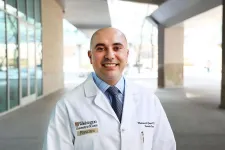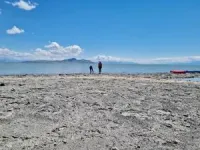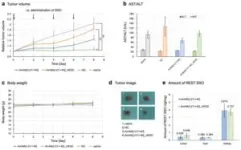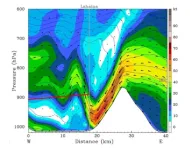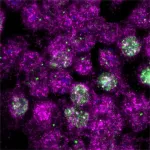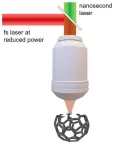(Press-News.org) Mohamed A. Zayed, MD, PhD, a vascular surgeon known for his pioneering research in vascular diseases, has been appointed director of the newly established Division of Surgical Sciences in the Department of Surgery at Washington University School of Medicine in St. Louis. He will assume his new role July 1.
Zayed, a professor of surgery, of radiology, of molecular cell biology, and of biomedical engineering, has more than 25 years of experience leading multifaceted research programs in biotech, medical startups and academia. Among his current roles, he oversees the school’s Vascular Surgery Tissue BioBank.
“Dr. Zayed is an outstanding academic surgeon who brings incredible passion and dedication to our shared goal of building a division that advances research and innovation in cutting-edge diagnostics, therapies, and technologies,” said John A. Olson Jr., MD, PhD, head of the Department of Surgery and the William K. Bixby Professor of Surgery.
Driven by the impactful contributions of surgeon-scientists, the new division will build upon the Department of Surgery’s long-standing legacy of excellence and innovation to advance team science and foster the next generation of innovative surgeons. The division comprises five sections that encompass the breadth of surgical research conducted in the Department of Surgery: Surgical Technology & Bioengineering, Transplant & Immunology Research, Surgical Therapeutics, Regenerative Science, and Multi-omics & Molecular Science.
Zayed’s research explores how lipid synthesis molecules impact the peripheral arterial wall, leading to advanced atherosclerosis, particularly in individuals with diabetes. His team has identified how immune modulation through therapy or diet can reduce inflammation in the aortic wall, thereby preventing aneurysm growth and rupture. His laboratory’s bioengineering focus has led to the development of multiple in vitro diagnostics and medical devices, including an implantable graft designed to help individuals with diabetes naturally produce insulin. His work has led to more than 45 patent filings, four issued U.S. patents and several biomedical startup companies.
Zayed joined Washington University in 2014 with the goal of building a research program to improve care for patients with end-stage vascular disease. Shortly after arriving, he received the Foundation to Advance Vascular Cures Wylie Scholar Award, a grant given annually to an outstanding young vascular surgeon-scientist dedicated to combining clinical practice with innovative research. He used the award to build his laboratory’s research infrastructure, including the creation of the Vascular Surgery BioBank, which collects vascular tissue and blood specimens for scientific investigations.
His innovative research programs have since received more than $25 million in funding from the National Institutes of Health (NIH) and other organizations, including an American Surgical Association research fellowship award and the Society for Vascular Surgery Foundation research investigator award.
Zayed’s research has sparked cross-campus collaborations with faculty in the university’s engineering and business schools and led to several business ventures through the St. Louis-based BioGenerator investment platform. In 2022, Zayed co-founded the CardioVascular Research Innovation in Surgery & Engineering (CVISE) Center. This multidisciplinary research center aims to synergize investigators from various disciplines to tackle persistent gaps in cardiovascular clinical care through innovations in medical diagnostics and therapeutics. The CVISE Center recently received a $6 million grant to provide surgical trainees and doctoral-level engineering students with specialized training in medical innovation, clinical translation and product commercialization.
Zayed has co-founded and led three biomedical companies, including Caeli Vascular Inc., a startup developing a device to treat large volume deep vein thrombosis (DVT). Licensed by the Washington University Office of Technology Management, the device is intended to make DVT treatment safer and more efficient by confining therapies to a single, minimally invasive intervention site. He serves as chief medical officer and primary investigator for the venture.
Zayed also maintains an active clinical practice, and his dedication to educating medical students, surgical residents and fellows has been recognized with multiple teaching awards.
He earned a bachelor’s degree in biology from the University of North Carolina at Chapel Hill. He then entered North Carolina’s Medical Scientist Training Program, where he received a doctoral degree in pharmacology in 2007 and his medical degree in 2009. He completed his residency in vascular surgery at Stanford University Medical Center. In 2023, he earned an executive MBA at Washington University’s Olin Business School.
END
Zayed to lead new Division of Surgical Sciences
Vascular surgeon to advance innovative patient care, research
2024-07-03
ELSE PRESS RELEASES FROM THIS DATE:
How dust pollution from shrinking Great Salt Lake affects communities disproportionately
2024-07-03
New research from the University of Utah demonstrates how wind-carried dust from the exposed bed of Great Salt Lake is disproportionately affecting disadvantaged communities in the Salt Lake metro area.
The findings suggest restoring the lake to a healthy water level would reduce disparities in harmful dust exposure experienced by different racial/ethnic and socioeconomic groups, along with delivering other ecological and economic benefits.
Exposure to particulate pollution arising from dry portions of the playa is highest among Pacific Islanders and Hispanics and lowest among white people compared to other racial/ethnic ...
Clever clothes! Seams in clothing capture body movement
2024-07-03
Everyday clothing may soon be able to capture and record body movements according to new research published by the Universities of Bristol and Bath.
Harmless low voltages are passed through conductive threads which are stitched into garment seams to create electrical circuits. Their resistance changes with the movement of the wearer's body. The work opens up new possibilities to make digital clothing which senses and captures movements much more accurately than is possible using current phones and smart watches.
The paper, presented at the Designing Interactive Systems (DIS) conference in Copenhagen ...
AMS science preview: Maui wildfire, Salt Lake drying, traffic and weather
2024-07-02
The American Meteorological Society continuously publishes research on climate, weather, and water in its 12 journals. Many of these articles are available for early online access–they are peer-reviewed, but not yet in their final published form.
Below is a selection of articles published early online recently. Some articles are open-access; to view others, members of the media can contact kpflaumer@ametsoc.org for press login credentials.
JOURNAL ARTICLES
Understanding Observed Precipitation Change and the New Climate Normal from the Perspective of Daily Weather Types in the Southeast U.S.
Journal of ...
Research spotlight: Identifying genes to prolong an anti-tumor immune response
2024-07-02
How would you summarize your study for a lay audience?
We set out to identify genes that are commonly expressed in CD8+ T cells, killer immune cells that can drive anti-tumor immunity, across many types of human cancers. Our goal was to uncover new therapeutic targets, which could inform novel treatment strategies that could benefit many patients. To do this, we developed a novel mathematical method that can be applied to data from many types of cancers.
What knowledge gaps does your study help to fill?
We know the presence fof CD8+ T cells is essential for ...
SRI is developing a new malaria treatment that aims to protect from the disease
2024-07-02
SRI today announced that researchers are developing a new treatment that aims to provide a better option to fight malaria, particularly for people in low-income and rural regions. Researchers in SRI’s Pharmaceutical Sciences Lab are working on an affordable, shelf-stable anti-malarial drug formulation that could provide months of protection against the mosquito-borne disease with just a single injection, which means that individuals would no longer have to worry about missing a dose. Additionally, it has a low propensity for resistance and can be ...
UV radiation damage leads to ribosome roadblocks, causing early skin cell death
2024-07-02
In a recent study, researchers at Johns Hopkins Medicine suggest the cell’s messenger RNA (mRNA) — the major translator and regulator of genetic material — along with a critical protein called ZAK, spur the cell’s initial response to UV radiation damage and play a critical role in whether the cell lives or dies.
While UV radiation has long been known to damage DNA, it also damages mRNA, and the latest findings, published June 5 in Cell, indicate that mRNAs act as first responders in telling the cells how to manage the stress.
“RNA is a canary in the coal mine. It’s telling the cell, ‘We’ve got major damage here and ...
Precise and less expensive 3D printing of complex, high-resolution structures
2024-07-02
WASHINGTON — Researchers have developed a new two-photon polymerization technique that uses two lasers to 3D print complex high-resolution structures. The advance could make this 3D printing process less expensive, helping it find wider use in a variety of applications.
Two-photon polymerization is an advanced additive manufacturing technique that traditionally uses femtosecond lasers to polymerize materials in a precise, 3D manner. Although this process works well for making high-resolution microstructures, it isn’t widely used in manufacturing ...
AGS member, George Kuchel, appointed to serve on ACIP
2024-07-02
The American Geriatrics Society extends its warmest congratulations to ADGAP President George Kuchel, MD, CM, FRCP on his appointment as a member expert of the Advisory Committee on Immunization Practices (ACIP). ACIP develops recommendations on the safe use of vaccines in the United States.
Dr. Kuchel, who became President of the Association of Directors of Geriatrics Academic Programs in spring 2024, is Director of both the UConn Center on Aging and the Claude D Pepper Older Americans Independence Center at the University of Connecticut. He has significant expertise and knowledge in vaccines and immunology, particularly in older adults, including performing ...
Researchers awarded Department of Defense grant to study the role of gut microbiomes to improve outcomes in dystonia
2024-07-02
Mohammad Moshahid Khan, PhD, principal investigator and associate professor in the Department of Neurology in the College of Medicine at the University of Tennessee Health Science Center, was recently awarded a $308,000 grant from the Department of Defense for a study that will investigate the role of the gut microbiome in dystonia, a movement disorder of abnormal postures and involuntary twisting or repetitive movements, to improve neurobehavioral outcomes. Jianfeng Xiao, MD, PhD, associate professor in the Department of Neurology, is the co-investigator of the study.
Although ...
Advancing toward a preventative HIV vaccine
2024-07-02
LA JOLLA, CA and NEW YORK, NY—A major challenge in developing a vaccine for HIV is that the virus mutates fast—very fast. Although a person initially becomes infected with one or a few HIV strains, the virus replicates and mutates quickly, resulting in a “swarm” of viral strains existing in a single body. But scientists at Scripps Research; IAVI; the Ragon Institute of Mass General, MIT, and Harvard; La Jolla Institute for Immunology; and additional institutions have conducted a series of preclinical ...
LAST 30 PRESS RELEASES:
JULAC and Taylor & Francis sign open access agreement to boost the impact of Hong Kong research
Protecting older male athletes’ heart health
KAIST proposes AI-driven strategy to solve long-standing mystery of gene function
Eye for trouble: Automated counting for chromosome issues under the microscope
The vast majority of US rivers lack any protections from human activities, new research finds
Ultrasound-responsive in situ antigen "nanocatchers" open a new paradigm for personalized tumor immunotherapy
Environmental “superbugs” in our rivers and soils: new one health review warns of growing antimicrobial resistance crisis
Triple threat in greenhouse farming: how heavy metals, microplastics, and antibiotic resistance genes unite to challenge sustainable food production
Earthworms turn manure into a powerful tool against antibiotic resistance
AI turns water into an early warning network for hidden biological pollutants
Hidden hotspots on “green” plastics: biodegradable and conventional plastics shape very different antibiotic resistance risks in river microbiomes
Engineered biochar enzyme system clears toxic phenolic acids and restores pepper seed germination in continuous cropping soils
Retail therapy fail? Online shopping linked to stress, says study
How well-meaning allies can increase stress for marginalized people
Commercially viable biomanufacturing: designer yeast turns sugar into lucrative chemical 3-HP
Control valve discovered in gut’s plumbing system
George Mason University leads phase 2 clinical trial for pill to help maintain weight loss after GLP-1s
Hop to it: research from Shedd Aquarium tracks conch movement to set new conservation guidance
Weight loss drugs and bariatric surgery improve the body’s fat ‘balance:’ study
The Age of Fishes began with mass death
TB harnesses part of immune defense system to cause infection
Important new source of oxidation in the atmosphere found
A tug-of-war explains a decades-old question about how bacteria swim
Strengthened immune defense against cancer
Engineering the development of the pancreas
The Journal of Nuclear Medicine ahead-of-print tip sheet: Jan. 9, 2026
Mount Sinai researchers help create largest immune cell atlas of bone marrow in multiple myeloma patients
Why it is so hard to get started on an unpleasant task: Scientists identify a “motivation brake”
Body composition changes after bariatric surgery or treatment with GLP-1 receptor agonists
Targeted regulation of abortion providers laws and pregnancies conceived through fertility treatment
[Press-News.org] Zayed to lead new Division of Surgical SciencesVascular surgeon to advance innovative patient care, research
